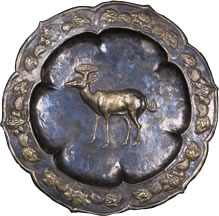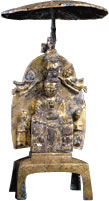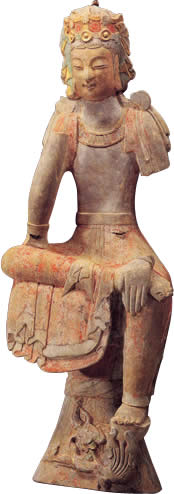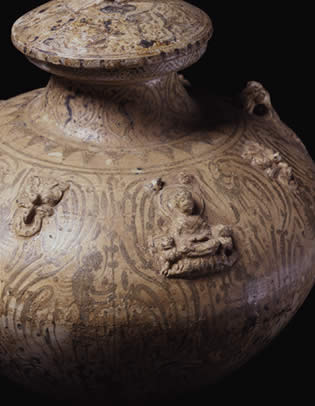
 Necklace
NecklaceGold, red opal, lapis lazuli, tourmaline, pearl
Sui dynasty, dated 608
Excavated from Tomb of Li Jingxun,
Xian Shaanxi Province
National Museum of China

Bird-Headed Ewer with Molded Decoration
Celadon
Tang dynasty, c. 7th century
Thought to have been excavated from Jixian,
Henan Province
The Palace Museum Beijing
Celadon
Tang dynasty, c. 7th century
Thought to have been excavated from Jixian,
Henan Province
The Palace Museum Beijing
Color on wood, silk
Tang dynasty, 7th century
Excavated from Tomb 206, Astana, Turfan,
Xinjiang Uygur Autonomous Region Museum
The rulers of the Tang dynasty, which followed the period of the unification of China under the Sui in the 6th century, subdued the nomadic tribes of the North Asian grasslands, defeated the Gaochang kingdom of Outer Asian, and gained control over the Eastern Turks. By the 7th century, the Tang dominated the northern routes of the Western Regions and built an empire. Its capital Chang'an (now Xian) was a cosmopolitan center, which drew together envoys, merchants, and artisans from its tributary states as well as from areas such as Central Asia and Iran.
In the first half of the 8th century, at the zenith of its international and cultural exchange, the Tang produced imaginative and colorful ceramic figurines and other objects and three-colored glaze ware, and incorporated many motifs from Central Asia and Southeast Asia on their metal ware and textiles. Many of the designs represented auspicious patterns, which had their origins in traditional spiritual symbols. New motifs were also created. The exquisite and expressive figure paintings on the walls of tombs exude liveliness, and the images of landscapes drawn with a sense of perspective became an independent theme in painting.

Platter with Deer Motif
Gilt Silver
Tang dynasty, 8th century
Excavated at Dayejiyu, Kuancheng, Hebei Province
Hebei Provincial Museum

Seated Buddha in Meditation
Gilt bronze
Wu Hu or Sixteen Kingdoms period, 4th century
Excavated at Shijiazhuang,
Hebei Province
Hebei Provincial Museum

Standing Buddha Shakyamuni
Gilt bronze
Northern Wei dynasty, inscribed 475
Excavated at Manchang,
Hebei Province
Hebei Provincial Museum


